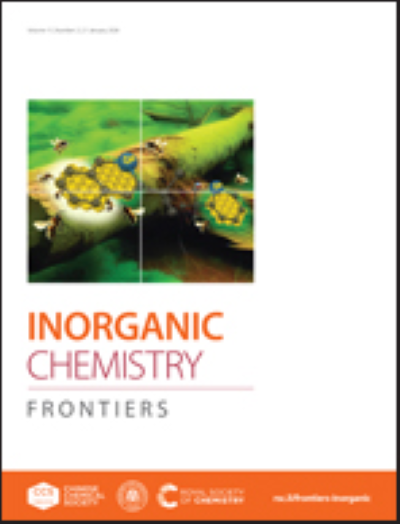Ca2La(MS4)(BS3) (M = Ge/Si and Sn/Si): High performance infrared nonlinear optical materials designed by atomic site co-occupancy strategy
IF 6.1
1区 化学
Q1 CHEMISTRY, INORGANIC & NUCLEAR
引用次数: 0
Abstract
Exploration of new material systems and optical performance enhancement are huge challenges during the study of infrared nonlinear optical (IR NLO) materials. In this work, the first thioborate-thiogermanate and thioborate-thiostannate, Ca2La(Ge0.72Si0.28S4)(BS3) and Ca2La(Sn0.75Si0.25S4)(BS3), containing both co-occupied Ca2+/La3+ cation and [Ge/SiS4]4- or [Sn/SiS4]4-anion sites, have been designed through an atomic site co-occupancy strategy. They inherited favourable 3D network structures in which the effectively aligned [MS4]4- and [BS3]3- functional anions are bridged by Ca2+/La3+ cations. Remarkably, the title compounds achieved excellent IR NLO properties, including good chemical and thermal stabilities, wide light transmission ranges (0.45-11 μm), strong second harmonic generation responses (1.5 and 2.0 times that of commercial AgGaS2 at 2.05 µm) and high laser induced damage thresholds (7 and 6 times that of AgGaS2). Theoretical calculation and experimental results revealed that, on the basis of excellent structural framework, introducing more active functional groups through atomic site co-occupancy can simultaneously enhance the second harmonic generation effect and maintain a relatively high laser induced damage threshold. This work not only offers an easier synthetic route for mixed anionic thioborates, but also provides inspiration for the design of well-performed NLO materials.Ca2La(MS4)(BS3) (M = Ge/Si和Sn/Si):采用原子位共占有策略设计的高性能红外非线性光学材料
在红外非线性光学(IR NLO)材料的研究中,探索新的材料体系和增强光学性能是一个巨大的挑战。在这项工作中,通过原子位点共占用策略设计了第一个含有共占用Ca2+/La3+阳离子和[Ge/SiS4]4-或[Sn/SiS4]4-阴离子的硫代酸盐-硫代甘酸盐和硫代酸盐-硫代锡酸盐Ca2La(Ge0.72Si0.28S4)(BS3)和Ca2La(Sn0.75Si0.25S4)(BS3)。它们继承了良好的三维网络结构,其中有效排列的[MS4]4-和[BS3]3-功能阴离子由Ca2+/La3+阳离子桥接。值得注意的是,标题化合物具有优异的红外NLO性能,包括良好的化学和热稳定性,宽的透光范围(0.45-11 μm),强的二次谐波产生响应(在2.05µm处是商用AgGaS2的1.5和2.0倍)和高的激光诱导损伤阈值(是AgGaS2的7和6倍)。理论计算和实验结果表明,在良好的结构框架基础上,通过原子位共占用引入更多活性官能团,可以在增强二次谐波产生效应的同时,保持较高的激光诱导损伤阈值。这项工作不仅为混合阴离子硫硼酸盐的合成提供了一条更简单的途径,而且为设计性能良好的NLO材料提供了灵感。
本文章由计算机程序翻译,如有差异,请以英文原文为准。
求助全文
约1分钟内获得全文
求助全文
来源期刊

Inorganic Chemistry Frontiers
CHEMISTRY, INORGANIC & NUCLEAR-
CiteScore
10.40
自引率
7.10%
发文量
587
审稿时长
1.2 months
期刊介绍:
The international, high quality journal for interdisciplinary research between inorganic chemistry and related subjects
 求助内容:
求助内容: 应助结果提醒方式:
应助结果提醒方式:


